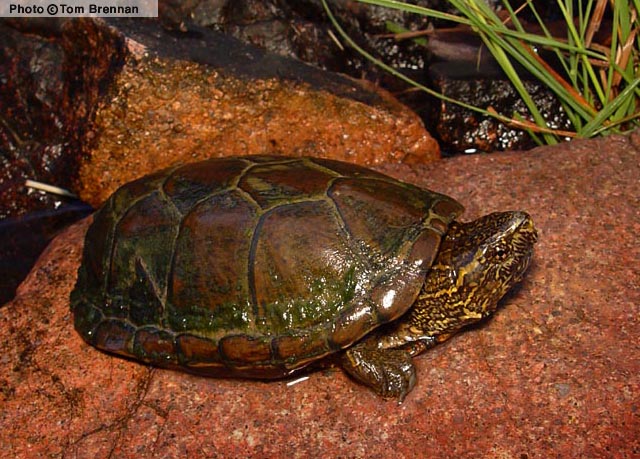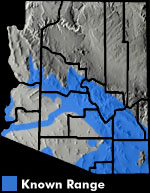Online Field Guide to The Reptiles and Amphibians of Arizona



Santa Cruz County, AZ
| SONORA MUD TURTLE Kinosternon sonoriense | |
|
DESCRIPTION: A small (shell up to 175 mm or 7″ in length ) turtle with an olive or gray-brown, dome-shaped shell. The top part of the shell (carapace) has three mild lengthwise keels. The underside of the shell (plastron) is usually yellow-brown and has two hinges so that the front and back can close when the turtle retreats inside. There are small, fleshy projections on the throat. The head and neck are marked with yellow or cream colored reticulations on a dark olive background. The feet are webbed. The markings on the head and neck distinguish this turtle from our other mud turtles. DISTRIBUTION: It occurs across most of southeastern and sub-Mogollon Rim central Arizona. It is found in the Salt and Gila rivers and their tributaries, tributaries of the Colorado River in west-central Arizona, the Colorado River near Yuma, and several drainages flowing south into Mexico from southeastern and south-central Arizona. It occurs at elevations ranging from near sea level in the lower Colorado River to over 6,500′. HABITAT: In Arizona this turtle inhabits biotic communities ranging from Lower Colorado River Sonoran Desertscrub through the woodlands. Usually found in rocky streams, creeks, and rivers. It also inhabits ponds, cattle tanks, and ditches. BEHAVIOR: Primarily diurnal in spring and fall but can be active at any time of the day or night during the hot summer months. It is aquatic but often travels overland between bodies of water. During the cold months of late fall and winter it hibernates in the soil under the water or in cavities along the bank. When captured or threatened it may emit a foul smelling musk from glands on the sides of the body. REPRODUCTION: This turtle mates in the water during spring and lays a clutch of up to 11 brittle-shelled eggs in an underground nest. SUBSPECIES FOUND IN AZ: By Thomas C. Brennan Brennan, T. C., & A. T. Holycross. 2006. A Field Guide to Amphibians and Reptiles in Arizona. Arizona Game and Fish Department. Phoenix, AZ Brennan, T. C., & A. T. Holycross. 2005. A Field Guide to Amphibians and Reptiles of Maricopa County. Arizona Game and Fish Department. Phoenix, AZ Stebbins, R.C. 2003. A Field Guide to Western Reptiles and Amphibians, Third Edition. Houghton Mifflin Company, Boston, MA. |
|
Visit Partners in Amphibian and Reptile Conservation:


HOME
Copyright © 2023, Arizona Game and Fish Department. All rights reserved.
If you make use of the textual contents of this site in reports, publications, etc. please cite and credit the author(s) and photographer(s). All photos on this website are copyrighted. However, those found in the species account section may be used for any noncommercial scientific, educational, or conservation purposes provided that photographs are not altered and continue to bear the copyright symbol and name of the photographer. Please contact the photographer regarding commercial use of copyrighted photographs.










